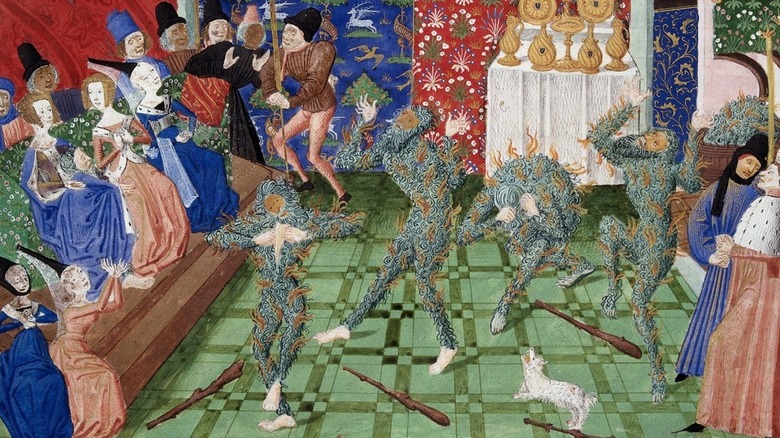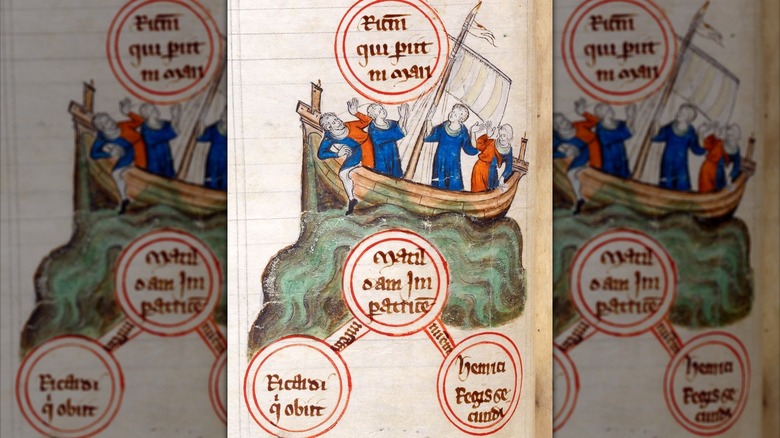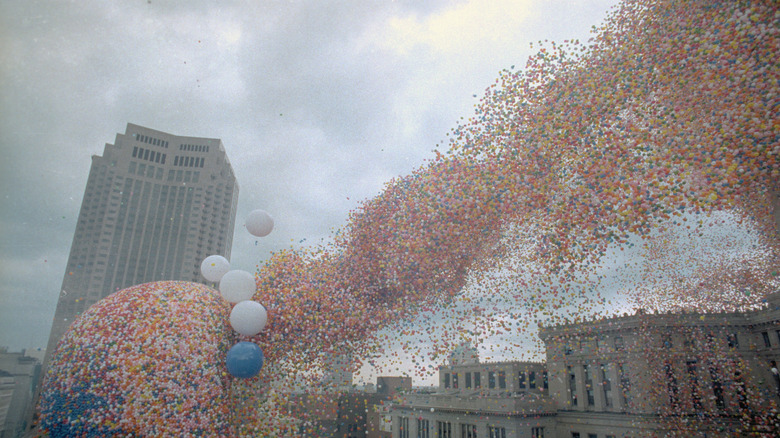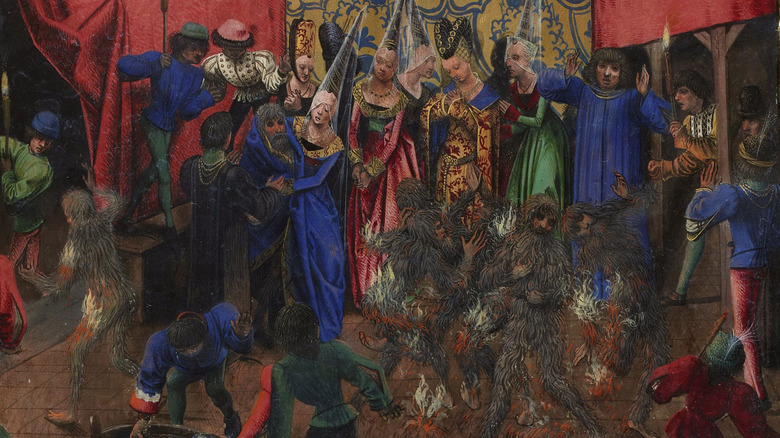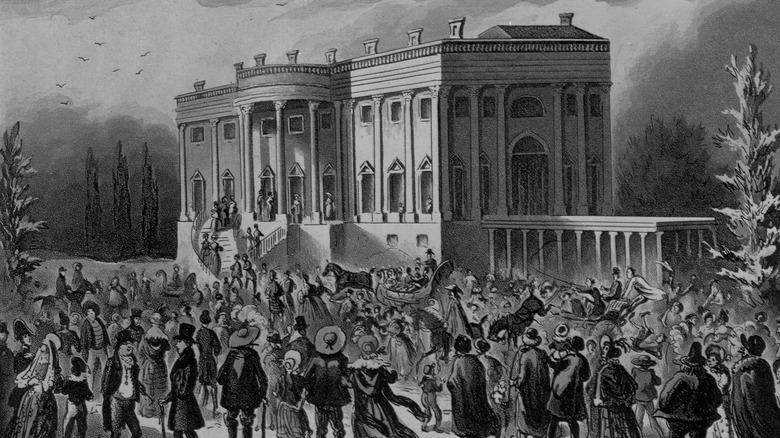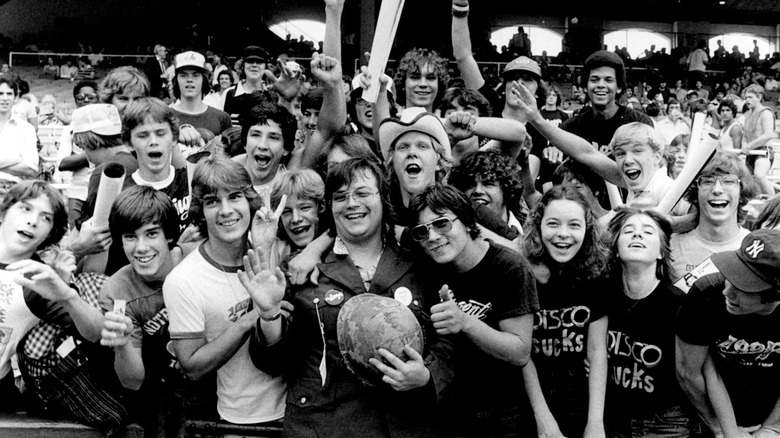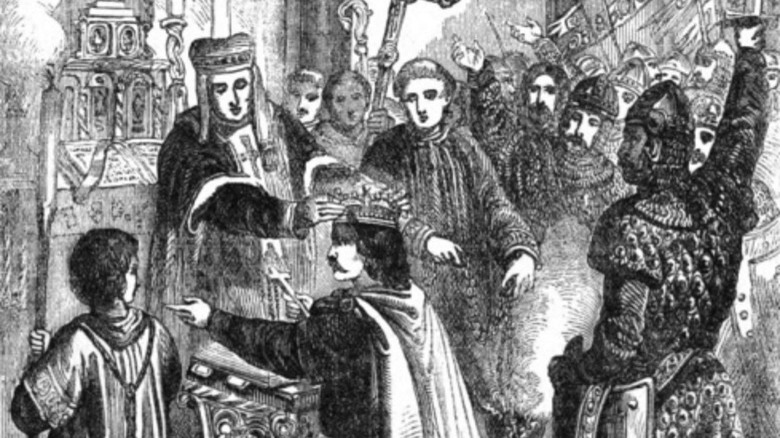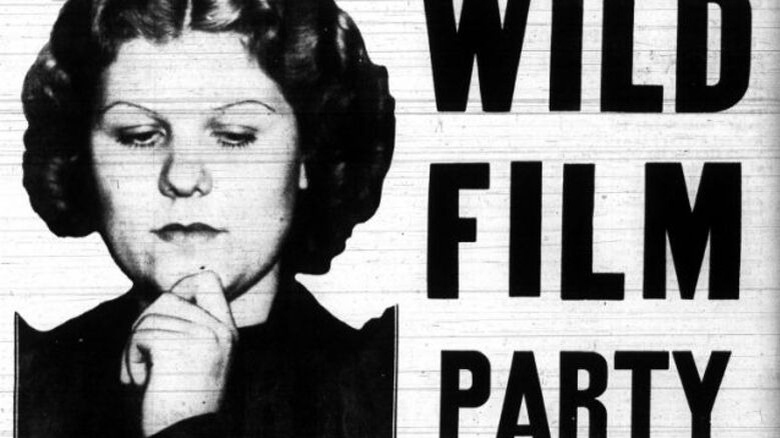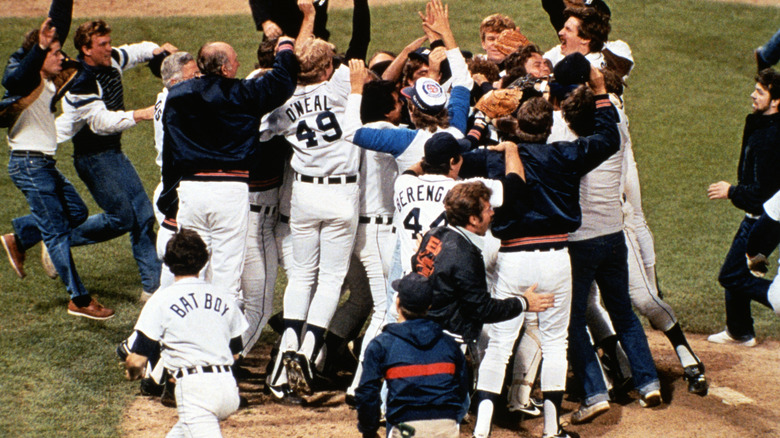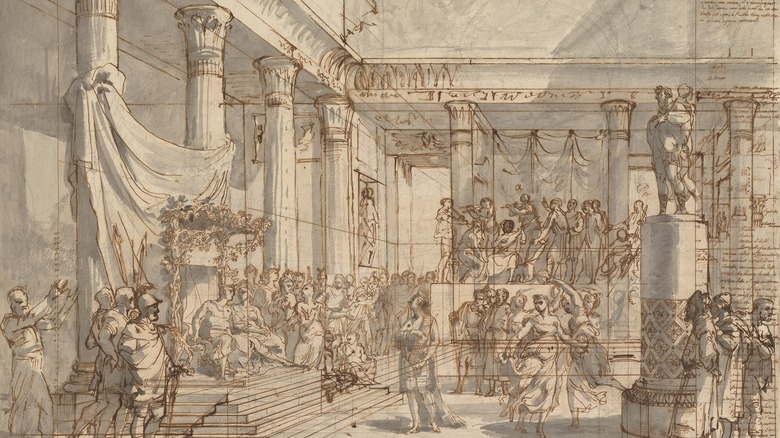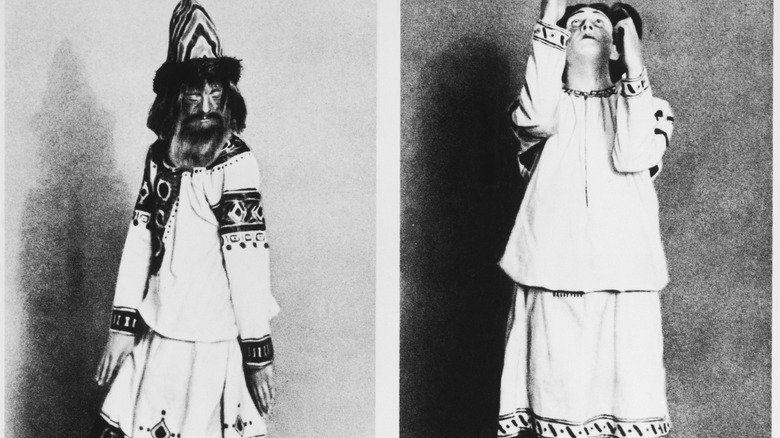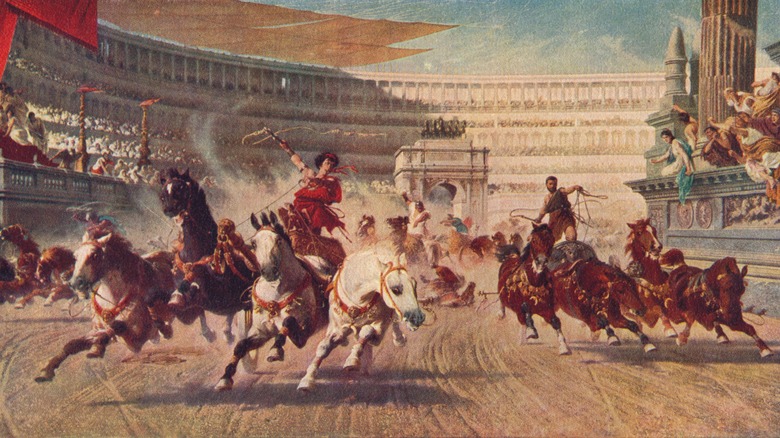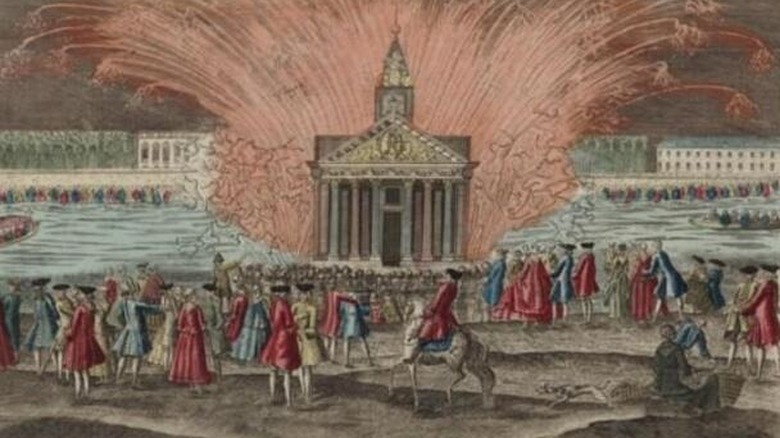Celebrations Throughout History That Got Out Of Control
When picturing a party getting out of control, the first images that come to mind for most people today are probably chaotic house parties, frat ragers, or maybe an accidentally explosive gender reveal. Wild parties are hardly a modern phenomenon, though. Combining alcohol with a crowd of excited, celebrating people has the potential to end in disaster, no matter what century the party is being held.
Throughout history, celebrations like weddings, sporting events, and political victory parties have gotten more raucous than their organizers could handle, leading to destruction, violence, and sometimes even deaths. Sometimes events that started out as light-hearted parties would have unintended consequences.
From baseball fans rioting and destroying their own team's stadium to victorious conquerors celebrating too hard and accidentally burning their hard-won palaces to the ground, celebrations big and small have gotten out of control.
White Ship disaster
On November 25, 1120, the heir to the English throne, 17-year-old William Adelin, was returning home to England on a vessel named the White Ship after visiting the court of French King Louis VI. While his father, King Henry I, sailed straight home, the prince and his friends had other plans. As soon as they were alone, they threw a massive party. Soon, all the young nobles onboard were drunk, and many of the men working as the ship's crew were drinking too. The helmsman, who was responsible for steering the ship, was also intoxicated and steered the ship directly into a rock near the shore. The White Ship, which was carrying the heir to the throne and many of the next generation of young English aristocrats onboard, began to sink.
The crew attempted to save the prince, but according to one account, he refused to stay on the lifeboat when he realized that his sister, Matilda, was trapped onboard. In the commotion, more terrified people tried to climb onto the lifeboat than it could hold, sinking as well. Ultimately, everyone on board was killed except for a butcher named Berold. The death of the prince, who was King Henry I's heir, would cause chaos in England. A civil war broke out, sending England into a 19-year period known as the Anarchy — essentially a succession battle between Henry's named heir, Matilda, and his nephew, Stephen of Blois, who seized the crown after Henry's death.
Baloonfest '86
As part of a charity fundraiser for United Way, on September 25, 1986, almost 1.5 million balloons were released in the Public Square in Cleveland, Ohio, in a successful attempt to shatter a previous world record for the most balloons released (achieved by Disneyland the year before). Hundreds of people traveled to Cleveland to help to inflate balloons, and the event was considered a massive success -– at first. Although the balloons looked majestic as they soared into the air en masse, eventually they had to burst and come back to earth. When they did, they would become a disaster, causing destruction and costing lives.
Deflated balloons littered the state, threatening wildlife, farm animals, and even shutting down an airport runway. Many fell into the ocean, only to wash up on beaches by the thousands. Most disturbingly, many of the balloons coated the surface of Lake Erie, preventing the Coast Guard from finding two people who were lost on the lake. Both died before they could be rescued.
Ball of the Burning Men
By 1393, King of France Charles VI was known as Charles the Mad because he suffered from delusional episodes, including once becoming startled by a loud noise that he killed five of his knights and believing that his entire body was made out of glass. His wife, Queen Isabeau (whom he would often fail to recognize), spent much of her time trying to come up with things to keep her husband entertained and distracted from his delusions. One of these events was an enormous party on January 28 to celebrate the wedding of one of her favorite ladies-in-waiting. The entertainment that she planned would turn into a disaster.
The entertainment was a dance called charivari, which, in this case, was a noisy performance meant to tease the newlyweds. Six of the king's knights performed soaked in pitch, wearing masks, and covered in long hair to make them look monstrous. Secretly, the king was also dressed as one of the dancers.
Open flames were actually banned during the dance, due to the costumes pretty much being a fire hazard. However, the king's brother and his friends didn't get the memo and arrived late and drunk carrying burning torches, after the dancing had already started. Horrifically, one of the pitch-soaked dancers caught fire from the spark of one of the late-comers' torches. In his desperation to save himself, he accidentally lit the other dancers too. The king and one other dancer survived, but the others burned to death in front of the crowd.
Andrew Jackson's inauguration party
Since Thomas Jefferson's inauguration, there was a tradition that after a new president was elected they would host an event at the White House. These events were open to anyone who wanted to come and meet the new president and were very respectable affairs in which other politicians and invited guests congratulated the newly elected president. Then in 1829, Andrew Jackson was elected. His inauguration celebration on March 4 quickly turned into a raucous party.
An enormous crowd arrived at the White House. Exactly how much damage Jackson's supporters did at the party is debated, but most accounts agree that in their desire to get to Jackson (and the free refreshments) the crowd got fairly rowdy. It is believed that some knocked over staff, spilled drinks on the carpet, stood on furniture, and even searched off-limits rooms in hopes of meeting the new president. While those opposed to Jackson's presidency described lots more petty vandalism and destruction of White House property, it's unclear just how out of hand the celebration became. To many, it became a symbol of how Jackson appealed to the common man, for better or worse.
Ultimately, White House staff was forced to put massive tubs of free whiskey out on the White House lawn to lure the disorderly celebrants out and had to spend months trying to get the smell of cheese out of the carpets.
Disco Demolition Night
In 1979, the radio station WLUP offered a special promotion during which fans could trade a disco record and just 98 cents for a ticket to a much-anticipated Chicago White Sox versus Detroit Tigers doubleheader at Comiskey Park on July 12. The plan was to destroy the records during the game –- but it would also lead to the destruction of the field.
As described in an article from The Guardian, this wasn't a lighthearted bit. The DJ behind the promotion was Steve Dahl, who had a personal vendetta against the genre of disco, partly because he had lost his last gig when the station became a disco station. While Dahl insisted that it was simply about dislike of a controversial genre, disturbingly, many fans interpreted it as any record from a Black artist and brought many non-disco albums to be destroyed. As the fans arrived, their records were thrown into a dumpster and they were given their heavily discounted ticket. The promotion was far more popular than even Dahl had expected, bringing almost 48,000 people into the game.
Between the two games, Dahl had all of the disco records put in the center of the field and blown up. There was chaos. Thousands of fans rushed onto the field and refused to return to the stands for the second game. The bonfire blazed on, the field was destroyed, and there were 39 arrests. The White Sox were forced to forfeit the game.
William the Conqueror's coronation
After a several-month campaign, bloody battles, and a pervasive rumor that he was dead, William the Conqueror was finally crowned king on Christmas 1066. The coronation was held at Westminster Abbey, and it was surrounded by armed guards to prevent any final attempts to stop William from being crowned. This seemingly judicious decision would lead to disaster when the celebration became too boisterous.
When William the Conqueror was crowned, his supporters cheered wildly. From outside, it sounded like they were under attack. The guards responded by setting the building on fire. Although many present had been with the new king through a rebellion, an invasion, and numerous battles, onlookers described this as the only time William the Conqueror showed real fear. As described by 11th century historian and monk, Orderic Vitalis (quoted via The History Press,) the crowd was still celebrating the coronation when they realized that there was a fire. Most of the people inside stampeded towards the exits, and many attempted to loot Westminster Abbey in the chaos as they fled.
MGM's stag party
On May 5, 1937, MGM hired 120 women as dancers and extras, apparently for an overnight on-location shoot. When the women arrived, however, they discovered that they had been lied to: There was no film shoot. Instead, they had been hired to attend a party that was being thrown as a reward for MGM's salesmen. There were celebrity guests and unlimited drinks, but the real entertainment was supposed to be the unsuspecting women who had been tricked into being there.
As described by documentarian and Hollywood biographer David Stenn in an interview with History, it was assumed that while men were at these parties they could behave however they wanted. As the party guests got more intoxicated, some became aggressive with the women, trying to touch them against their will. None of the women at the party had transportation away from the event or access to a phone, so there was no easy way out. As noted by Vanity Fair, one 18-year-old actually had to fight her way out with the help of actor Wallace Beery, the two fleeing the building. Another, Patricia Douglas, was unable to break free and was violently force-fed alcohol by two men, beaten, and raped. When she attempted to sue MGM, she was silenced by the studio.
If you or anyone you know has been a victim of sexual assault, help is available. Visit the Rape, Abuse & Incest National Network website or contact RAINN's National Helpline at 1-800-656-HOPE (4673).
[Image by Daily News via Wikimedia Commons | Cropped and scaled | CC BY-SA 4.0]
1984 Tigers' victory
In 1984, life was tough in Detroit, with unusually high unemployment and crime rates. There wasn't much to celebrate. Then, in front of more than 50,000 fans, the Detroit Tigers won the World Series for the first time in 16 years on October 14. Despite heavy rains, the streets erupted into mass celebration.
Soon, the chanting fans got rowdy. Many threw their empty beer bottles, leaving shards of broken glass everywhere the crowd went. Several people were admitted to the hospital after being struck by the bottles. As the night went on, the police responded to reports of fireworks and smoke bombs. They responded by arriving in riot gear to make arrests. A group of around 40 fans targeted an empty police car and set it on fire. Elsewhere, more fans did the same to a taxi. There were dozens of arrests, but the police were unable to prevent the fans from ripping apart the stadium for souvenirs of the event.
Despite the destruction, staff at the game and even the police themselves were quoted in a report from The New York Times as being glad the fans had a chance to celebrate, even if it became chaotic.
Alexander the Great conquers Persepolis
After defeating the Persian Emperor in 330 B.C.E., Alexander the Great's army took the Persian capital city, Persepolis. The city was famously home to much of the Persian Empire's greatest wealth and achievements, including silver, gold, jewelry, art, and books. As described by first-century historian Diodorus Siculus (via World History Encyclopedia), Alexander planned a massive celebration for his conquering army during which he sacrificed many animals to the gods, had an entire feast prepared, and allowed his men to loot the city. He also provided them with massive quantities of alcohol, which would turn out to be a mistake.
Alexander and all his men got extremely drunk and increasingly violent. According to legend, an Athenian woman named Thais used this situation to her advantage. She was probably one of Alexander's generals' girlfriends, but she may have also had a romantic relationship with Alexander himself. Her home city of Athens had been burned by the Persians 150 years before, and she encouraged the intoxicated Alexander and his generals to set fires in retribution. While the band played on, Alexander and his men joyfully put the great city to the torch. The next morning, Alexander reportedly regretted destroying Persepolis –- especially the priceless books and art.
Stravinsky's The Rite of Spring
In Paris on May 29, 1913, the famous composer Igor Stravinsky premiered the ballet "The Rite of Spring" performed by a troupe of Russian ballet dancers. While one might think that putting on a new ballet would be a quiet, dignified celebration of the arts, in reality, it would become one of the most debated events in the history of performing arts.
The ballet told the story of an imagined pagan ritual during which a sacrificial dancer would dance until she died of exertion. As noted by classical music critic Ivan Hewett for the British Library, the music was immediately controversial, partially because it was so different from Stravinsky's previous work. The dancing choreographed by Vaslav Nijinsky certainly also riled up the crowd, because it was a radical departure from what anyone expected from ballet.
According to some who were present, the crowd was disturbed by the performance and began shouting over the music. Some witnesses claimed that the audience threw things at the performers, while others described something more like a brawl, with members of the audience fighting each other. Despite the apparent chaos, the dancers and musicians continued to perform the show to the end. When it was over, the sound of clapping and cheering battled with the noise of the rest of the crowd. Exactly what happened at the first performance of "The Rite of Spring" is still unknown, but it is believed that there may have been as many as 40 arrests.
Nika Riots
Although circuses and festivals were supposed to be celebrations to entertain the people, the circus and the games held in Constantinople's Hippodrome were serious business. In fact, chariot racing was so important to Byzantine life that charioteers rubbed shoulders with the emperor himself, and supporters of different factions (known as Blues and Greens) had an intense rivalry that could turn violent. In A.D. 532, however, one crowd got so riled up during a chariot race that the two factions actually joined forces against Emperor Justinian.
A few days before the big race, several members of the Blue and Green factions had narrowly escaped their own executions and were still wanted. During the race on January 13, the fans chanted for Justinian to pardon the men. As Justinian ignored their demands, the event grew rowdier and rowdier, until it became a full-scale uprising. The crowds at the Hippodrome often chanted "nika" or "victory" for their team, but this time, they chanted it for themselves. The revolt lasted for five days, with rioting Blues and Greens setting fire to the city of Constantinople. Finally, Justinian called in the army, who trapped the two factions inside the chariot racing track and began killing everyone inside. It is estimated that as many as 30,000 people were killed during the Nika riots.
Ten Cent Beer Night
In 1974, the Cleveland Indians were having a terrible season. Many fans had stopped showing up to baseball games, leaving the stadium disappointingly empty. In an effort to improve fan attendance and morale, a promotion was offered for the upcoming game: 10 cent beer.
At the time the Texas Rangers had a promotion where beer only cost a dime that had gone well, so the Indians planned the same. Any fan in the stadium would be able to buy their drinks for just a few cents each. When 25,000 fans arrived at the stadium (around twice as many as were expected at similar games) on June 4 they came to drink. Things escalated throughout the game, with several fans streaking across the field nude, a few people throwing things at the players, and even a couple firecrackers being set off in the stands. Soon, it devolved into chaos. The Rangers manager reported seeing fans with knives and chains menacing the opposing team, and the Indians actually took to the field with their bats to help protect the Rangers from the fans.
The wedding of Marie-Antoinette and Louis XVI
King Louis XVI and Queen Marie-Antoinette were both executed by guillotine during the French Revolution, but their marriage was a blight on the French people from the very beginning. After some 10 years of negotiations with the Austrian Empire, in 1770 France had secured a peace treaty by marrying its prince, the future King Louis XVI, to the Austrian archduchess Marie-Antoinette. Their marriage was celebrated with a massive party on May 30, ending with a fireworks display in Paris. Fireworks were rare at the time, and never set off in places where common people could see them, so when people heard about the show they flocked to the streets of Paris. It was extremely crowded.
During the finale of the fireworks display, one of the rockets set the wooden launch platform on fire. At first, the crowd thought that the blaze was intentional, but it soon became obvious that the fire was dangerous. Nobility and ordinary people alike tried desperately to escape the fire. Even the newly married royal couple had to struggle to escape in their carriage. The surging crowd became a stampede, trampling anyone unlucky enough to be forced to the ground underfoot. Many people were killed in the chaos, with official death tolls ranging from 132-800.
